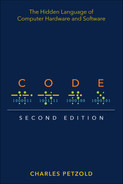Computers are everywhere --- most obviously in our laptops and smartphones, but also our cars, televisions, microwave ovens, alarm clocks, robot vacuum cleaners, and other smart appliances. Have you ever wondered what goes on inside these devices to make our lives easier but occasionally more infuriating? For more than 20 years, readers have delighted in Charles Petzolds illuminating story of the secret inner life of computers, and now he has revised it for this new age of computing. Cleverly illustrated and easy to understand, this is the book that cracks the mystery. Youll discover what fl ashlights, black cats, seesaws, and the ride of Paul Revere can teach you about computing --- and how human ingenuity and our compulsion to communicate have shaped every electronic device we use. This new expanded edition explores more deeply the bit-by-bit, gate-by-gate construction of the heart of every smart device the central processing unit that combines the simplest of basic operations to perform the most complex of feats. Along with new chapters, Petzold has created a new website, CodeHiddenLanguage.com, that uses animated interactive graphics to make computers even easier to comprehend. From the simple ticking of clocks to the worldwide hum of the internet, Code reveals the essence of the digital revolution. .
Table of Contents
- Cover Page
- Title Page
- Copyright Page
- Contents
- Preface to the Second Edition
- Pearson’s Commitment to Diversity, Equity, and Inclusion
- About the Author
- Definition of Code
- Chapter One. Best Friends
- Chapter Two. Codes and Combinations
- Chapter Three. Braille and Binary Codes
- Chapter Four. Anatomy of a Flashlight
- Chapter Five. Communicating Around Corners
- Chapter Six. Logic with Switches
- Chapter Seven. Telegraphs and Relays
- Chapter Eight. Relays and Gates
- Chapter Nine. Our Ten Digits
- Chapter Ten. Alternative 10s
- Chapter Eleven. Bit by Bit by Bit
- Chapter Twelve. Bytes and Hexadecimal
- Chapter Thirteen. From ASCII to Unicode
- Chapter Fourteen. Adding with Logic Gates
- Chapter Fifteen. Is This for Real?
- Chapter Sixteen. But What About Subtraction?
- Chapter Seventeen. Feedback and Flip-Flops
- Chapter Eighteen. Let’s Build a Clock!
- Chapter Nineteen. An Assemblage of Memory
- Chapter Twenty. Automating Arithmetic
- Chapter Twenty-One. The Arithmetic Logic Unit
- Chapter Twenty-Two. Registers and Busses
- Chapter Twenty-Three. CPU Control Signals
- Chapter Twenty-Four. Loops, Jumps, and Calls
- Chapter Twenty-Five. Peripherals
- Chapter Twenty-Six. The Operating System
- Chapter Twenty-Seven. Coding
- Chapter Twenty-Eight. The World Brain
- Index
- Colophon
- Code Snippets
